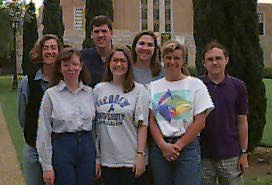 THE
EXPERIMENT GROUP'S EXCITING
EXPERIMENTS
THE
EXPERIMENT GROUP'S EXCITING
EXPERIMENTS  THE
EXPERIMENT GROUP'S EXCITING
EXPERIMENTS
THE
EXPERIMENT GROUP'S EXCITING
EXPERIMENTS The Experiment Group performed three main experiments: the pendulum, the parabola, and the inclined plane. We also made a simple water clock, tested its accuracy, and used it as a timepiece for the inclined-plane experiment. At the beginning, we examined some of the secondary literature in order to decide which experiments we would do. We wanted experiments that we could be sure Galileo had performed and that were fundamental and simple to perform and demonstrate to the class. Galileo did not have a stopwatch; therefore, measuring time intervals was a problem. He used his resting pulse-rate, musical rhythm, and a waterclock. Since only trained musicians can discern minute variations from a regular tempo, and the pulse is inaccurate, we decided to make a water clock to keep time.
We thought about doing the Leaning Tower exeriment, but this turned out to be perhaps more of a legend than an actual experiment. It is doubtful whether Galileo performed the experiment, and if he performed it, exactly how he performed it (for example we do not know the size and material of the balls). Another question was, what was Galileo attempting to prove when he "performed" the experiment. His theories of falling bodies changed with time.
We chose to do the three experiments mentioned above because Galileo did them, they were easily repeatable, and fundamental. The inclined plane experiment shows that the distance a uniformly accelerated body travels is proportional to the square of the elapsed time. For example, a ball traveling a quarter of the length takes half the time it that it takes to travel the whole distance. The pendulum experiment shows that the period is proportional to the square of the length of the pendulum. Further, bobs raised to different heights at the start of the experiment take the same time (or nearly so) to complete one cycle: the period is independent of th e amplitude. The fact that bobs made of different densities have the same periods shows that they have a constant acceleration, which contradicts Aristotle's claim that objects of different weights fall at different speeds. The parabola experiment refut es the Aristotelian notion that different kinds of motion (natural and forced) do not mix. According to this theory, a projectile moves in a single direction until the initial force is depleted, after which it falls straight down. The parabola experiment shows that projectile motion is a mixture of constant velocity in one direction and uniformly accelerated motion in another.
Last revised April 17, 1995
Audra Lewis
audra@owlnet.rice.edu